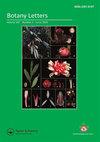Plant–pollinator interactions in ultramafic and non-ultramafic environments in New Caledonia
IF 1.3
4区 生物学
Q3 PLANT SCIENCES
引用次数: 2
Abstract
ABSTRACT Edaphic conditions operate major environmental filtering on plant assemblages and their community structure. Soils derived from ultramafic outcrops (i.e. ultramafic substrates) are characterized by high concentrations of metal and metalloid and nutrient deficiencies constraining plant growth. Due to the coupled effects of edaphic conditions and climate, tropical ultramafic substrates harbour a very particular flora. New Caledonia, one of the main plant biodiversity hotspots worldwide, owes much of its exceptional biodiversity to ultramafic substrates. While the flora of the New Caledonian ultramafic substrates is well known, its pollinating fauna remains to be described. Here, we describe plant–pollinator interactions in some ultramafic and non-ultramafic environments in New Caledonia, with a particular focus on wild alien, native and domestic bees. Wild alien bees were less diverse and less present in ultramafic environments than in non-ultramafic ones; we only recorded six interactions realised by wild alien bee species in ultramafic environments. Apis mellifera was also less present in ultramafic environments. Regarding native bees, they were equally present in both environments but less diverse in non-ultramafic environments. Our results suggest that ultramafic environments may filter alien pollinators. Due to beekeeping, Apis mellifera thrived and was the most active species in both environments. Further studies are needed to explore the diversity of interactions in ultramafic environments and to test whether metal and metalloid found in ultramafic substrates such as nickel may transfer to pollinators through plant rewards.新喀里多尼亚超基性和非超基性环境中植物-传粉者的相互作用
土壤条件对植物群落及其群落结构起着重要的环境过滤作用。来自超镁铁质露头(即超镁铁质底物)的土壤的特征是金属和类金属的高浓度和营养缺乏,限制了植物的生长。由于土壤条件和气候的耦合作用,热带超基性基质孕育着一种非常特殊的植物群。新喀里多尼亚是世界上主要的植物生物多样性热点地区之一,其独特的生物多样性在很大程度上归功于超基性基质。虽然新喀里多尼亚超基性基质的植物群是众所周知的,但其授粉动物群仍有待描述。在这里,我们描述了新喀里多尼亚一些超密和非超密环境中植物与传粉者的相互作用,特别关注野生外来蜜蜂、本地蜜蜂和家养蜜蜂。与非超镁铁环境相比,野生外来蜜蜂在超镁铁环境中的多样性和数量较少;我们只记录了六种野生外来蜜蜂在超热带环境中实现的相互作用。在超湿地环境中蜜蜂的数量也较少。至于本地蜜蜂,它们在两种环境中都同样存在,但在非超环境中多样性较低。我们的研究结果表明,超密性环境可能会过滤外来传粉者。由于养蜂,蜜蜂在两种环境中都茁壮成长,是最活跃的物种。需要进一步的研究来探索超镁基环境中相互作用的多样性,并测试在镍等超镁基基质中发现的金属和类金属是否可以通过植物奖励转移给传粉者。
本文章由计算机程序翻译,如有差异,请以英文原文为准。
求助全文
约1分钟内获得全文
求助全文
来源期刊

Botany Letters
Agricultural and Biological Sciences-Plant Science
CiteScore
3.10
自引率
6.70%
发文量
54
期刊介绍:
Botany Letters is an international scientific journal, published by the French Botanical Society (Société botanique de France) in partnership with Taylor & Francis. Botany Letters replaces Acta Botanica Gallica, which was created in 1993, building on over a century of renowned publications by the Société botanique de France.
 求助内容:
求助内容: 应助结果提醒方式:
应助结果提醒方式:


